



















|
 |
|
 |

Although considered to be different from their Makedonian neighbours to the east & southern Greeks to the south, the Epeirotes are heavily influenced by their military traditions, so much in fact, there is hardly any difference between a Makedonian & Epeirote army. Phalanxes & cavalry dominate Epeirote armies in addition to Illyrian troops of various capability.
Hoplitai Haploi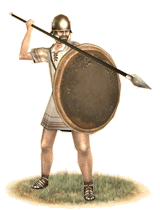 The poorest citizens of the Hellenic and Makedonian poleis fought as a militia roughly organized along the lines of other, more professional hoplite soldiers. They are organized in the phalanx and are quite high quality for militia, due to the dogged Hellenic spirit and fighting tradition. They can be expected to hold a line against most light and medium infantry, though they will be devastated by missile troops, as they have virtually no protection from missiles aside from their shields and the bodies of their compatriots. They are still useful against cavalry as no horse will willingly charge a bristling wall of spear points. Hoplitai Haploi, if used properly, can be an inexpensive and very valuable unit, though they will be outclassed against heavier and more professional troops, they can, if well supported, hold the line far better than one would expect of a militia. The poorest citizens of the Hellenic and Makedonian poleis fought as a militia roughly organized along the lines of other, more professional hoplite soldiers. They are organized in the phalanx and are quite high quality for militia, due to the dogged Hellenic spirit and fighting tradition. They can be expected to hold a line against most light and medium infantry, though they will be devastated by missile troops, as they have virtually no protection from missiles aside from their shields and the bodies of their compatriots. They are still useful against cavalry as no horse will willingly charge a bristling wall of spear points. Hoplitai Haploi, if used properly, can be an inexpensive and very valuable unit, though they will be outclassed against heavier and more professional troops, they can, if well supported, hold the line far better than one would expect of a militia.
Historically, the poorest citizens of any polis and the peasants on the estates of Makedonia were called up in defense of their homeland to fight as militia. They had been used to devastating effect in many ancient battles while forming the second line of battle. They were good and courageous soldiers that fought with a degree of discipline and courage that would not be thought possible of an unprofessional milita. They were not cowards and did not break quickly, but were often annihilated if facing good missile troops or heavier, more professional infantry. Peltastai and other units armed with javelins were particularly devastating to the militia hoplites, due to their lack of protection on the battlefield.
Phalangitai Deuteroi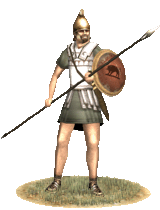 The Phalangitai Deuteroi are wealthier members of Makedonian or Eperiot society than the majority of peasants, but are still not in the class required to be considered Pezhetairoi (voting property owners), yet they can afford better equipment than their poorer taxeis hoplitai brethren. They are armored in good Phrygian helmets, quilted cloth armor that can dampen the effects of missiles, and are armed with the dreaded sarissa, a six meter long pike. They are disciplined enough to hold a line well, and as property owners, have a lot to lose if a battle does not go their way. They can be used as decent defensive infantry, well able to hold their own against most enemies, so long as that enemy is attacking from the front. They are still vulnerable to missiles and flanking attacks, though not as vulnerable as their less wealthy compatriots. They are more disciplined and better motivated than their Asian or Aigyptian counterparts in the armies of the Seleukidai or Ptolemaioi. The Phalangitai Deuteroi are wealthier members of Makedonian or Eperiot society than the majority of peasants, but are still not in the class required to be considered Pezhetairoi (voting property owners), yet they can afford better equipment than their poorer taxeis hoplitai brethren. They are armored in good Phrygian helmets, quilted cloth armor that can dampen the effects of missiles, and are armed with the dreaded sarissa, a six meter long pike. They are disciplined enough to hold a line well, and as property owners, have a lot to lose if a battle does not go their way. They can be used as decent defensive infantry, well able to hold their own against most enemies, so long as that enemy is attacking from the front. They are still vulnerable to missiles and flanking attacks, though not as vulnerable as their less wealthy compatriots. They are more disciplined and better motivated than their Asian or Aigyptian counterparts in the armies of the Seleukidai or Ptolemaioi.
Historically, the Phalangitai Deuteroi were only used during periods of extreme need or times when Makedon was invaded. They represent the lower end of the smallholder class, and as such, are the primary food providers of the social order. They were used only rarely, usually during invasions. They did give a good account of themselves against the Galatai and Thraikes invaders, but were found wanting as the armies of Philippos V and his son were cut down by Romaioi soldiers.
Akontistai (Hellenic Skirmishers)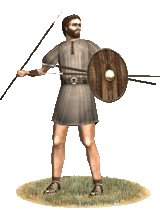 Those unlucky enough to be extremely poor freedmen were pressed into service as psiloi, missile units, and the lowest class of Hellene infantry. The psiloi were divided into three parts: javelineers, slingers, and archers. The javelin-armed psiloi, the akonistai, were ragged peasants armed with javelins and small knives. Their function was simply to throw their missiles and then run as fast as possible to safety behind the hoplitai lines. They were used for skirmishing and to provide a demoralizing hail of missile fire during the grinding battle between the two phalanxes. Never use akonistai in melee except as diversionary fodder or as a flanking force; roles in which they don't excel, but might actually be better than nothing. They have their uses, as their javelins are still sharp and deadly, but they were often used only as light skirmishers or as a last resort in Hellenic armies for obvious reasons. Those unlucky enough to be extremely poor freedmen were pressed into service as psiloi, missile units, and the lowest class of Hellene infantry. The psiloi were divided into three parts: javelineers, slingers, and archers. The javelin-armed psiloi, the akonistai, were ragged peasants armed with javelins and small knives. Their function was simply to throw their missiles and then run as fast as possible to safety behind the hoplitai lines. They were used for skirmishing and to provide a demoralizing hail of missile fire during the grinding battle between the two phalanxes. Never use akonistai in melee except as diversionary fodder or as a flanking force; roles in which they don't excel, but might actually be better than nothing. They have their uses, as their javelins are still sharp and deadly, but they were often used only as light skirmishers or as a last resort in Hellenic armies for obvious reasons.
Historically, akontistai did not play a particularly large role on the battlefield, and weren't normally a particularly decisive force. They were used mainly for their ability to induce an enemy to attack prematurely. They are little more than an annoyance on the open field, but can be deadly if positioned in places where their javelins can be used for maximum effect: on high terrain, on an enemy unit's flank, or atop a city wall.
Sphendonetai (Hellenic Slingers)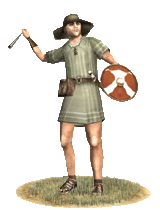 Sphendonetai are the second branch of the psiloi, and are only marginally more useful than their compatriots with javelins. Their sphendonai (slings) can prove deadly weapons, being able to crush bones and armor, and shatter shields from a distance, but they are mainly used to harass and annoy enemy soldiers to force a premature or rash action. Since a sphendone is an easily constructed weapon, and ammo is readily available in Hellas' rocky terrain, Sphendonetai are mostly poor peasants and shepherds that use this weapon to provide a meager amount of protein in their already poor diet or use their weapons to keep predators away from their flocks. Sphendonetai are the second branch of the psiloi, and are only marginally more useful than their compatriots with javelins. Their sphendonai (slings) can prove deadly weapons, being able to crush bones and armor, and shatter shields from a distance, but they are mainly used to harass and annoy enemy soldiers to force a premature or rash action. Since a sphendone is an easily constructed weapon, and ammo is readily available in Hellas' rocky terrain, Sphendonetai are mostly poor peasants and shepherds that use this weapon to provide a meager amount of protein in their already poor diet or use their weapons to keep predators away from their flocks.
Historically, sphendonetai had their uses, they were often used to harass and provoke the enemy forces by causing some casualties and some damage to the enemy's armament, particularly the shields, which were easily dented or cracked by a well slung glande (sling projectile). Alexandros employed his sphendonetai at the battle of Gaugamela to harass the Persian heavy cavalry until they decided to give fight, and then promptly cut them off from the rest of the Persian army, allowing the Hetairoi to cut them to shreds.
Toxotai (Hellenic Archers)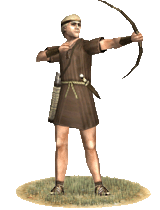 Toxotai are the third branch of the psiloi, the archers of Hellene and Makedonian armies. They are generally from the upper end of the poor and recruited from mountainous regions where the use of the bow is an essential skill to keep one's flock of sheep safe from roving predators. Toxotai are well trained in a manner of speaking, that being that they are using their weapon of choice (often of necessity) from birth. They are decent archers, but are nowhere near as professional as the archers from the east and south. They mostly use the short bow, which means that they are often outgunned by their counterparts from other lands. This reflects their secondary role in a Hellenic army. As most missile units, they will be cut to ribbons in melee, so they should be well protected from enemy ranks. Toxotai are the third branch of the psiloi, the archers of Hellene and Makedonian armies. They are generally from the upper end of the poor and recruited from mountainous regions where the use of the bow is an essential skill to keep one's flock of sheep safe from roving predators. Toxotai are well trained in a manner of speaking, that being that they are using their weapon of choice (often of necessity) from birth. They are decent archers, but are nowhere near as professional as the archers from the east and south. They mostly use the short bow, which means that they are often outgunned by their counterparts from other lands. This reflects their secondary role in a Hellenic army. As most missile units, they will be cut to ribbons in melee, so they should be well protected from enemy ranks.
Historically, the Hellenes did not use archers in any significant fashion. They did not have the composite bows of their neighbors, and their lands were not particularly suited to the cattle and horse farming that supplied the raw material for these bows. Therefore, archers fulfilled the same role as other psiloi: that of long range harassment. The Hellenes and Makedonians had no real tradition of archers and could not recruit any but these shepherds to do this work for them, since they lacked any access to the archers of the east. Most Hellene states relied on Skythian and most importantly Kretan archers to do this for them.
Phyletichoi Illyrioi (Illyrian Levy Spearmen)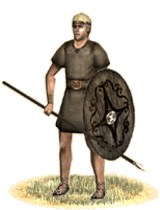 The most basic and numerous of the infantry units used by Epeiros were the Phyletichoi Illyrioi. The Illyrians have learned to fight in ordered formations and with short spears and javelins in order to break up the formations of their Greek enemy. They are not particularly reliable soldiers, but they are certainly better than their eastern counterparts. They can give a good account of themselves in battle if deployed properly. They wear no armor, and have only a light shield for protection, so most other infantry will slaughter them in droves. They can fend off light cavalry for a time, if need be. The most basic and numerous of the infantry units used by Epeiros were the Phyletichoi Illyrioi. The Illyrians have learned to fight in ordered formations and with short spears and javelins in order to break up the formations of their Greek enemy. They are not particularly reliable soldiers, but they are certainly better than their eastern counterparts. They can give a good account of themselves in battle if deployed properly. They wear no armor, and have only a light shield for protection, so most other infantry will slaughter them in droves. They can fend off light cavalry for a time, if need be.
Historically, the Illyrians were a people that inhabited the northern part of modern day Albania and were bordered in the south by the Greeks of Eperios and Aitolia, and in the east by Makedonia and Thessalia. Thus, they had to adapt their warfare to fight these enemies, a task they became frighteningly good at. By the time of Philippos of Makedonia, they had carved out a fairly large kingdom at the expense of Makedones and Epeirotai. Philippos married Olympias of Epeiros and retook the Makedonian and Epeirote provinces for their respective owners, using Parmenion to take the Makedonian portion back. His son Alexanderos, a product of this marriage alliance against the Illyrians, attacked, subdued, and won over many of the Illyrian tribes. Fairly large contingents of his light infantry in the Persian conquest were of Illyrian extraction. They won their independence once more after Alexanderos’ death, but were never again to become a major power. The Illyrioi as a people were extinguished by the Romanaioi and Illyria became the first Roman province outside of the western Mediterranean. The Illyrians adapted quickly to Roman culture and became the first extremely loyal non-Italic subjects of the growing Empire.
Hoplitai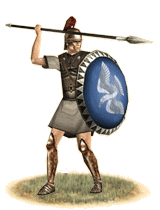 Even though the Makedonian phalangitai has become the dominant infantry type among the Hellenic powers, the hoplitai of old, those who fight in much the same manner as the Hellenes of Thermopylai, Marathon and Plataiai did, are still around defending their poleis. Each hoplites is equipped with linen or leather armor, an aspis shield, greaves, the attic style helmet and of course, his spear. Their equipment might have changed since the battles of a centuries past, but their tactics has not. The hoplitai still fight in the phalanx formation, often eight man deep whose purpose is to advance forward upon the enemy line, tie them and to whittle them down through attrition. Even though the Makedonian phalangitai has become the dominant infantry type among the Hellenic powers, the hoplitai of old, those who fight in much the same manner as the Hellenes of Thermopylai, Marathon and Plataiai did, are still around defending their poleis. Each hoplites is equipped with linen or leather armor, an aspis shield, greaves, the attic style helmet and of course, his spear. Their equipment might have changed since the battles of a centuries past, but their tactics has not. The hoplitai still fight in the phalanx formation, often eight man deep whose purpose is to advance forward upon the enemy line, tie them and to whittle them down through attrition.
Historically, the hoplites is one of the most famous types of soldiers that has ever existed. The Hellenic military ethos and culture from the 8th century and until the Roman hegemony created a highly skilled heavy infantryman. This combined with the phalanx formation, proved to be key factors in winning over the numerically larger Persian and barbarian armies of the day.
The hoplitai were mostly drawn from the well-to-do citizens of a polis, who often had a stake in the outcome of the battle or war to come, and who were bound to eachother by a patriotic feeling to their home city, creating a body of citizen-warriors whose motivation was unlike that of any levy, mercenary or other professional soldiers. The hoplites of the Hellenic city states continued to be the dominant infantry type on the battlefield for almost two centuries after the Persian Wars, but the appearance of the Peltastoi made them more vulnerable than before and highlighted the shortcomings of the phalanx, and the rise of Makedonia in the north and its phalangitai, became the decline of the "classical" hoplites being fielded in large numbers. However, variants of the hoplites were succesfully adapted by various Hellenic powers, like the Ekdromoi & Thorakitai Hoplitai. And even after the wars of Alexandros and those of his successors, some poleis and smaller communities still fielded contingents of hoplitai, who were trained and fought in the same fashion as the hoplitai of old.
Peltastai (Hellenic Heavy Skirmishers)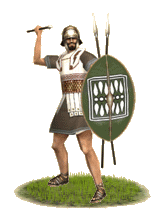 The Peltastai is a type of elite skirmisher that sacrifices heavy arms and armor for mobility and range. They are armored in linen and carry a medium sized ovular shield. Originally, they carried a crescent shaped 'pelta' shield, originated in Thrake and gave the peltastai their name, but this was phased out in the fourth century. Their armaments consist of several javelins and a sword. This panoply makes them light and mobile, but still able to engage in melee after their javelins have been thrown. They are a versatile unit but one must remember that their primary arms are javelins, and they are not equipped to stand toe to toe with heavier infantry. Their role is one of speed, harassment, and critical flanking maneuvers. The Peltastai is a type of elite skirmisher that sacrifices heavy arms and armor for mobility and range. They are armored in linen and carry a medium sized ovular shield. Originally, they carried a crescent shaped 'pelta' shield, originated in Thrake and gave the peltastai their name, but this was phased out in the fourth century. Their armaments consist of several javelins and a sword. This panoply makes them light and mobile, but still able to engage in melee after their javelins have been thrown. They are a versatile unit but one must remember that their primary arms are javelins, and they are not equipped to stand toe to toe with heavier infantry. Their role is one of speed, harassment, and critical flanking maneuvers.
Historically, the peltastai were often hoplitai or pezhetairoi equipped to fight in the manner of a skirmisher. This meant that they were adept melee combatants as well as being deadly with their javelins. Peltastai were used to great effect on ancient battlefields but by 270 BC the thureophoros was becoming the dominant melee skirmisher and the peltastai were carrying more javelins and were used in a manner that was consistent with this. This was simply a matter of specialization, and it did not mean that peltastai would be any less effective if deployed correctly. Their light armament makes them extremely fast, but tends to be to their detriment in melee combat. They were mostly used in the role of supporting missile troops who charged in at the last moment, after they had spent all their javelins. The great Athenian general Iphikrates is credited with the invention of the peltast as a distinct unit, and it is he that first employed them in this manner to great effect against the heavier armored and better trained hoplitai of Sparte.
Hippeis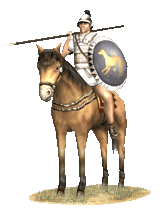 Hellene cavalry is not the most awe inspiring and powerful in the world, but nothing to be scoffed at either. Hippeis are a mix of good old fashioned Hellene know-how with the practical needs for an effective medium cavalry force. The result is the wedding of linen armor, Attik helmets, and hoplon shields to cavalry spears and the xiphos producing a warrior with excellent all-round equipment. Since they are mainly drawn from elite nobility, these cavalrymen have high morale and good discipline. They ride stout horses whose stock was imported from the north. They are an able, if not spectacular, medium cavalry. Hellene cavalry is not the most awe inspiring and powerful in the world, but nothing to be scoffed at either. Hippeis are a mix of good old fashioned Hellene know-how with the practical needs for an effective medium cavalry force. The result is the wedding of linen armor, Attik helmets, and hoplon shields to cavalry spears and the xiphos producing a warrior with excellent all-round equipment. Since they are mainly drawn from elite nobility, these cavalrymen have high morale and good discipline. They ride stout horses whose stock was imported from the north. They are an able, if not spectacular, medium cavalry.
Historically, Hellene cavalry was always thought of as better than Romaios cavalry, even though it was not particularly significant. The Hellenes have enough trouble keeping the equestrian Makedonians to the north at bay without having to worry about doing much of significance.
Hippakontistai (Hellenic Skirmisher Cavalry)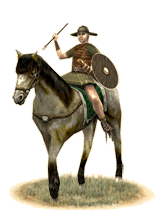 Hippos Akontistes (literally "javelin horsemen") are the standard among Hellene light cavalry. They are lightly armored, often wearing nothing but padded cloth for protection. The key to their method of warfare is speed, and they are armed accordingly. They ride small, but swift horses and harass enemy infantry and heavy cavalry with javelins. This is their primary use, because their light armor is really a detriment when they are engaged in any kind of melee combat. Their swords and shields are simply no counter to lances or heavier cavalry swords. Hippos Akontistes (literally "javelin horsemen") are the standard among Hellene light cavalry. They are lightly armored, often wearing nothing but padded cloth for protection. The key to their method of warfare is speed, and they are armed accordingly. They ride small, but swift horses and harass enemy infantry and heavy cavalry with javelins. This is their primary use, because their light armor is really a detriment when they are engaged in any kind of melee combat. Their swords and shields are simply no counter to lances or heavier cavalry swords.
Historically, Hellas did not have a great tradition of light cavalry warfare, or indeed of any cavalry warfare. Hippakontistai were much like the Equites of Rome, the spoiled children of the richest families that could afford horses. They were usually not used in any front line capacity other than skirmishing and pursuit, and their equipment reflects this. Makedonian cavalry of the same type operates in a similar fashion, but generally comes from the poorest noble families, those who can afford horses but not the heavy armor required for the heavy cavalry.
Pezhetairoi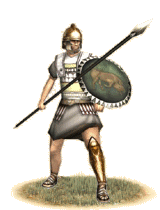 The Pezhetairoi are heart of the military machine of all the Diodachoi kindgoms. They are well disciplined and highly motivated pikemen that are armed and armored to the teeth. They are armored in a linen cuirass, a Thraikian cap, a bronze greave on the left leg, stout boots, good bracers, and reinforced shoulder pads made from hardened linen (due to their experience with the deadly curved swords of Thrace). They have Illyrian style round shields attached to their bodies by leather straps that help support the weight of the shield and keep their hand free to grasp the long and unwieldy sarissa. They are defensive infantry par excellence and are the anvil of the two part Makedonian system of warfare, the heavy cavalry being the hammer. They should be used to anchor enemy soldiers while the Theurophoroi harass the flanks and the heavy cavalry smashes into the flanks and rear. The Pezhetairoi are heart of the military machine of all the Diodachoi kindgoms. They are well disciplined and highly motivated pikemen that are armed and armored to the teeth. They are armored in a linen cuirass, a Thraikian cap, a bronze greave on the left leg, stout boots, good bracers, and reinforced shoulder pads made from hardened linen (due to their experience with the deadly curved swords of Thrace). They have Illyrian style round shields attached to their bodies by leather straps that help support the weight of the shield and keep their hand free to grasp the long and unwieldy sarissa. They are defensive infantry par excellence and are the anvil of the two part Makedonian system of warfare, the heavy cavalry being the hammer. They should be used to anchor enemy soldiers while the Theurophoroi harass the flanks and the heavy cavalry smashes into the flanks and rear.
Historically, the Pezhetairoi are the classic Alexandrian phalanx. They were used to great effect against the Persai, Medoi, Baktrioi, Indoi, Phoinikoi, and many, many others. They are an effective force and have not changed much over the centuries. The Romaioi were able to defeat them as easily as they did for two main reasons. One, the Romaioi army was at a high state of readiness and tactical prowess after defeating the Karchedoi. Two, the heavy cavalry arm of the Diodochoi armies had degenerated to the point where they were no longer able to field significant numbers to fulfill their part of the hammer and anvil tactic of Alexandros. There were also many lesser reasons, numbering among them the misuse of the Thureophoroi, the under use of Peltastai, and the lax state of warfare that the Diodachoi states were used to. In any case, the phalanx was not as anachronistic or inflexible as widely believed; it was simply misused and under-supported. In the thirteenth century and onwards, pikemen in similar formations were able to work wonders with more capable generals and a better cavalry arm. Do not under appreciate pikemen, for they are still a war winning force.
Thureophoroi (Hellenic Spearmen)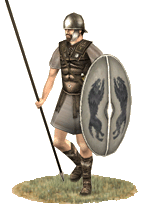 Thureophoroi were a new class of Hellenic infantry that was designed to both augment the phalanx and provide a type of soldier in between the phalangite and the peltastai that was able to both skirmish and fight in melee effectively. These men provide an extremely mobile force that can hit hard with their heavy javelins then rush in to flank pike units. They are well armed and armored for the task, having stout bronze helms, linen armor, an almond shaped thureos shield, heavy javelins, and a stout spear. They are highly versatile infantry, akin in spirit to the legionaries of Rome. They are a highly effective force of heavy infantry that is in the forefront of Hellenic military know-how. Thureophoroi were a new class of Hellenic infantry that was designed to both augment the phalanx and provide a type of soldier in between the phalangite and the peltastai that was able to both skirmish and fight in melee effectively. These men provide an extremely mobile force that can hit hard with their heavy javelins then rush in to flank pike units. They are well armed and armored for the task, having stout bronze helms, linen armor, an almond shaped thureos shield, heavy javelins, and a stout spear. They are highly versatile infantry, akin in spirit to the legionaries of Rome. They are a highly effective force of heavy infantry that is in the forefront of Hellenic military know-how.
Historically, Thureophoroi were used as harassing and flanking troops by the successor states. Though they were often described by Latin writers as copies of the legion, it is debatable whether they were developed with knowledge of warfare in Italy or not. Most Thureophoroi were Pezhetairoi, middle class property owners with voting rights, and as such, they were well able to devote time to training and practice and were highly disciplined and courageous troops. Despite their obvious advantages, or perhaps because of them, there was a lot of confusion as to how to utilize these new soldiers. As were deadly in the extreme to the less mobile phalanx units they forced a, much resisted, revaluation of Hellenic warfare. Perhaps for this reason the Diodachoi tended to used them conservatively, except for the Seleukidai, who took to these new soldiers quite well. The city-states of Hellas used them even more frequently against the armies of Makedonia, and were often able to hold the more powerful kingdom at bay. Still, their uses were limited in scope and not as widespread as their versatile and deadly role would have indicated. This is the fault of period commanders, however, and a more astute or innovative commander might have realized their potential in conjunction with the more static phalanx.
Thorakitai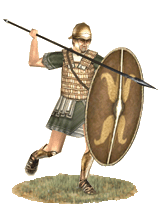 The Thorakitai represent the second evolution of the concept of the Theurophoroi, and show definite influence by the Romaioi in their implementation. They are armored in mail and carry heavy javelins instead of the lighter javelins carried by the Thureophoroi. They are more expensive and less mobile than their more lightly armored companions, but make excellent shock troops for any Hellenic army. They are best utilized on the flanks of the phalanx to either flank the enemy while the phalanx pins them, or prevent enemy flankers from attacking the phalanx's vulnerable flanks. They are best used in combination with the lighter Thureophoroi, who can support them with extra javelins and more importantly, speed, to make sure they are not surrounded. The Thorakitai represent the second evolution of the concept of the Theurophoroi, and show definite influence by the Romaioi in their implementation. They are armored in mail and carry heavy javelins instead of the lighter javelins carried by the Thureophoroi. They are more expensive and less mobile than their more lightly armored companions, but make excellent shock troops for any Hellenic army. They are best utilized on the flanks of the phalanx to either flank the enemy while the phalanx pins them, or prevent enemy flankers from attacking the phalanx's vulnerable flanks. They are best used in combination with the lighter Thureophoroi, who can support them with extra javelins and more importantly, speed, to make sure they are not surrounded.
Historically, the Thorakitai were used much like the Thureophoroi, but more rarely and later on. They were expensive soldiers, and one had to be fairly wealthy to equip one's self as a Thorakites. They were only used in any real numbers by the Seleukidai and the city-states of Hellas. They were never used to their full potential until the Romaioi raised legions in Hellas, and the type of fighting practiced by the Romaioi Legions and Thorakitai became the norm rather than the exception.
Prodromoi (Successor Medium Cavalry)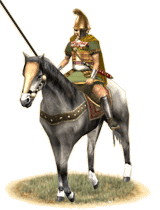 Prodromoi are the lightest of the Diadochoi melee cavalry and can be counted upon as superb flanking, raiding, and screening cavalry. They are well trained for light cavalry, but are still lightly armed and armored. They are not meant to be used as shock cavalry and will not roll up an enemy battle line in a thunderous charge, but instead make viable flanking cavalry which can quickly provide support where it is needed and be used to counter light missile troops of both the foot and mounted varieties. Their spears, shields, and linen armor give them some staying power, but they should not be used to in protracted melee for any great amount of time. Prodromoi are the lightest of the Diadochoi melee cavalry and can be counted upon as superb flanking, raiding, and screening cavalry. They are well trained for light cavalry, but are still lightly armed and armored. They are not meant to be used as shock cavalry and will not roll up an enemy battle line in a thunderous charge, but instead make viable flanking cavalry which can quickly provide support where it is needed and be used to counter light missile troops of both the foot and mounted varieties. Their spears, shields, and linen armor give them some staying power, but they should not be used to in protracted melee for any great amount of time.
Historically, the Seleukidai and Makedones used the smaller and weaker members of the nobility to form a quick and powerful light cavalry force that could decide an engagement on its own. Since these men are nobles, they have good staying power, as was evidenced by their widespread use in many battles. They are quick, and can be used to chase down missile cavalry when there is a need, due to the fact that they ride fast Thessalian horses and are relatively slight statured men. The Seleukidai use them as an effective counter to the Parthoi horse archers, much like the Hungarians of a later era did against the Turks.
Hippeis Thessalikoi (Thessalian Heavy Cavalry)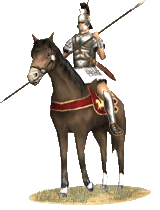 Thessalikoi heavy cavalry are drawn from the nobility of Thessalia, a region thoroughly under Makedonian control. They are extremely valuable heavy cavalry, well able to crush enemy resistance with a single thunderous charge. While not quite as powerful as the Hetairoi of Makedonia itself, the Thessalikoi are well able to give a good account of themselves in battle. Their lances and blades, combined with their shields, make them well able to hold in a melee after the charge has been completed and they have a degree of discipline that is enviable among cavalry warriors. Thessalikoi heavy cavalry are drawn from the nobility of Thessalia, a region thoroughly under Makedonian control. They are extremely valuable heavy cavalry, well able to crush enemy resistance with a single thunderous charge. While not quite as powerful as the Hetairoi of Makedonia itself, the Thessalikoi are well able to give a good account of themselves in battle. Their lances and blades, combined with their shields, make them well able to hold in a melee after the charge has been completed and they have a degree of discipline that is enviable among cavalry warriors.
Historically, Thessalia was famous for its heavy cavalry. Unlike southern Hellene regions, the Thessalikoi had a wide expanse of plains and were able to breed horses extensively. They were able to keep the other Hellenes at bay even though they were poorer and less populous than their southern neighbors. They were joined with Makedonia during the reign of Phillipos, and provided cavalry to fuel Alexandros’ conquests. After Alexandros, they continued to provide heavy cavalry to the Makedonians until the Rhomaios invasion of 146 BC that destroyed much of Thessalia’s infrastructure. There is evidence that by this time heavy cavalry was employed only in smaller numbers, due to cost.
Lonchophoroi Hippeis (Hellenic Medium Cavalry)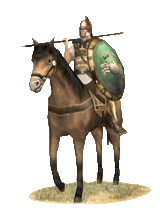 Hail Stratege! Fine noblemen forming a sturdy body of cavalry whose purpose is to crash into your foe and have the staying power to breach his line are here, arrayed before you. Armed with stout single handed lances and the mighty aspis of our ancestors, they can unleash a terrible charge. Once they have inflicted gruesome casualties on our enemies, they will switch to their melee weapon and begin a close-in slaughter. While men from Epeiros or Makedonia proper would have the sturdy Kopis, men further east may prefer the stout bladed war axe like that used by Alexander at the Granicus. They are armored with scale reinforced linen, greaves, and masked Phrygrian helmets that betray naught but the angry face of Zeus Pater or wrathful Poseidon. They are best used as a general purpose heavy cavalry. However, if facing the sturdier men from the east, or, Gods forbid, the elite Hetairoi or massive Kataphraktoi of the Seleukides and Baktrioi, they may not have the staying power that they would against other heavy cavalry. Use them well, and they will give your enemies naught but the death they so richly deserve! Hail Stratege! Fine noblemen forming a sturdy body of cavalry whose purpose is to crash into your foe and have the staying power to breach his line are here, arrayed before you. Armed with stout single handed lances and the mighty aspis of our ancestors, they can unleash a terrible charge. Once they have inflicted gruesome casualties on our enemies, they will switch to their melee weapon and begin a close-in slaughter. While men from Epeiros or Makedonia proper would have the sturdy Kopis, men further east may prefer the stout bladed war axe like that used by Alexander at the Granicus. They are armored with scale reinforced linen, greaves, and masked Phrygrian helmets that betray naught but the angry face of Zeus Pater or wrathful Poseidon. They are best used as a general purpose heavy cavalry. However, if facing the sturdier men from the east, or, Gods forbid, the elite Hetairoi or massive Kataphraktoi of the Seleukides and Baktrioi, they may not have the staying power that they would against other heavy cavalry. Use them well, and they will give your enemies naught but the death they so richly deserve!
Historically, the lancers of later Hellenistic armies were divided into several types. Some cavalry performed shock roles as a secondary function, with the charge itself being their goal, and thus it became necessary to develop a specific force of cavalry who could charge in suppport but lend staying power to their comrades. This sort of cavalry was used to great effect by the forces of Syrakousai and Taras in the west, Epeiros, Pergamon and Makedonia in the heartland of the Greek and Makedonian peoples, and the even the great Hellenistic kingdoms of Aigyptos, Syria, and Baktria. They appear on both sides at the battle of Magnesia, where they and the Pergamene Hetairoi checked the advance of more heavily armored Seleukid cavalry, allowing the Romans to roll up the line of Seleukid infantry. Still, they have some weaknesses, and should not be expected to defeat elite troops in prolonged battle.
Hetairoi Aspidophoroi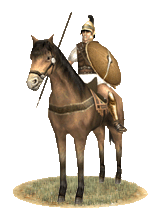 Hail Stratege! The men mounted before you are among your most vital cavalrymen. Armored in leather torso armour and carrying stout shields, they are well able to last in melee. After throwing their iron tipped javelins, they will retreat behind the shock cavalry, and then help to exploit the breakthrough made by the lancers by weight and skill. Do not misuse them, for they are an elite among your horsemen, and are difficult to replace. Still, they are well able to hold their own in virtually any melee, since each man's heavy kopis will deal death to those infantry who dare approach them. Hail Stratege! The men mounted before you are among your most vital cavalrymen. Armored in leather torso armour and carrying stout shields, they are well able to last in melee. After throwing their iron tipped javelins, they will retreat behind the shock cavalry, and then help to exploit the breakthrough made by the lancers by weight and skill. Do not misuse them, for they are an elite among your horsemen, and are difficult to replace. Still, they are well able to hold their own in virtually any melee, since each man's heavy kopis will deal death to those infantry who dare approach them.
Historically, the successor states fielded cavalry different from what Alexandros had used. These men solved a very practical problem: how do you soften up an infantry line for a charge, and then exploit it afterward? After the early days of the successor kingdoms, there were never enough men of this stature to make a massive impact on the battlefield. But, perhaps you will learn from the mistake of allowing your own opulence overshadow the needs of your army?
Agrianikoi Pelekephoroi (Agrianian Assault Infantry)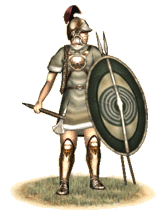 The Agrianians are an Illyrian tribe that has many Thracian influences. Most now live in northern Macedonia, where they are actively recruited. The Agrianians are famed for their acrobatics and climbing ability, and are well known as an exceedingly fierce tribe. They've been recruited by the Macedonians in large numbers for many years, and are now indebted to the Macedonian king for protecting them against the huge invasion of the Galatians. They wear little in the way of armor, wearing only a small round bronze breastplate that doubles as a bowl and leather greaves that protect their legs from the jagged rocks. They carry daggers and axes, both modified to use as climbing tools. Their daggers are particularly long and specially shaped to make them both climbing spikes and excellent melee weapons. They actually have a fairly advanced martial art based around these weapons. They carry thureoi and wear attic helmets, and round out their equipment with javelins. Agrianians are famous javelineers, able to throw their javelins farther and with more force than many others. They are best used as assault infantry, their javelins, speed, and axes can work wonders on heavier troops. They are fanatic soldiers who often lose themselves into a battle frenzy, able to tackle enemies with far more armor. They are among the best and fastest infantry available to the Macedonian Kingdom. The Agrianians are an Illyrian tribe that has many Thracian influences. Most now live in northern Macedonia, where they are actively recruited. The Agrianians are famed for their acrobatics and climbing ability, and are well known as an exceedingly fierce tribe. They've been recruited by the Macedonians in large numbers for many years, and are now indebted to the Macedonian king for protecting them against the huge invasion of the Galatians. They wear little in the way of armor, wearing only a small round bronze breastplate that doubles as a bowl and leather greaves that protect their legs from the jagged rocks. They carry daggers and axes, both modified to use as climbing tools. Their daggers are particularly long and specially shaped to make them both climbing spikes and excellent melee weapons. They actually have a fairly advanced martial art based around these weapons. They carry thureoi and wear attic helmets, and round out their equipment with javelins. Agrianians are famous javelineers, able to throw their javelins farther and with more force than many others. They are best used as assault infantry, their javelins, speed, and axes can work wonders on heavier troops. They are fanatic soldiers who often lose themselves into a battle frenzy, able to tackle enemies with far more armor. They are among the best and fastest infantry available to the Macedonian Kingdom.
Historically, the Agrianians were used by Alexander in almost every major battle of his conquest, often to a great effect. They were fanatically loyal and were called upon as his best assault troops, able to throw their ropes and grappling hooks and use their spiked boots and specialized equipment to scale even sheer surfaces. They fought fanatically and continued this tradition under Macedonian leadership.
Chaeonion Agema (Epeirote Elite Phalanx)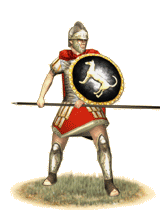 The Chaonion Agema are the infantry elite in the Epeirotes army. They are the elite phalangite infantry, and if phalangites are simply capable of holding a line, these soldiers are more than capable. They are armed with long pikes to keep the enemy at a distance, but should the enemy get too close, they are more competent than most phalangitai with their short swords. They should be deployed where the fighting will be hardest or the line will be most vulnerable, because they are less likely to turn and run when things get too hot than other infantry. A good phalanx commander should always remember that a phalanx' flank is always weak. The Chaonion Agema are the infantry elite in the Epeirotes army. They are the elite phalangite infantry, and if phalangites are simply capable of holding a line, these soldiers are more than capable. They are armed with long pikes to keep the enemy at a distance, but should the enemy get too close, they are more competent than most phalangitai with their short swords. They should be deployed where the fighting will be hardest or the line will be most vulnerable, because they are less likely to turn and run when things get too hot than other infantry. A good phalanx commander should always remember that a phalanx' flank is always weak.
Alexandros of Epeiros may have adopted phalagitai from Phillipos and his cousin, Megas Alexandros, but the tradition of infantry such as the Hypaspistai, Argyraspides, or Hetairoi were not available to the Epeirotes, who independently created their own elite forces. The Chaioniai Agemata are elite pikemen comparable the Argyraspidai.
Pheraspides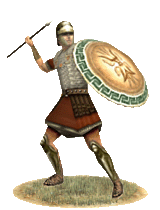 The Pheraspidai are the second part of the Basilikon Agema, or Royal Squadron. They are armed with large hoplites shields and swords and these are augmented by a few heavy javelins for added punch. These men are assault infantry, and are an arm of the heavy infantry used as a mobile reserve to plug gaps where the fighting is thickest and to storm fortresses. They wear heavy armor and have thick helmets to protect them from the rigors of hand-to-hand combat. They are an elite and expensive heavy infantry that are best used for their original purpose, since they are likely to bolster faltering infantry or slaughter garrison troops with ease. The Pheraspidai are the second part of the Basilikon Agema, or Royal Squadron. They are armed with large hoplites shields and swords and these are augmented by a few heavy javelins for added punch. These men are assault infantry, and are an arm of the heavy infantry used as a mobile reserve to plug gaps where the fighting is thickest and to storm fortresses. They wear heavy armor and have thick helmets to protect them from the rigors of hand-to-hand combat. They are an elite and expensive heavy infantry that are best used for their original purpose, since they are likely to bolster faltering infantry or slaughter garrison troops with ease.
Historically, the Pheraspidai, or assault shield bearers, were the elite of Alexandros' assault forces. After his death, they split up and slaughtered one another until being reformed by both the Seleukidai and the Makedones. They were used many times, but were all but wiped out when fighting the Parthoi, unsupported with light troops and cavalry of their own. Perhaps a crafty general can save them from their untimely doom...
Hypaspistai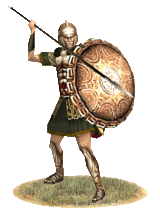 Hail, Basileu! Before you stand your Hypaspistai: the elite of the elite and your personal guard. They are armed and armored in the finest equipment of the traditional hoplite: aspis, greaves, cuirass, helmet, spear, and sword. They are the best and richest of your men; far too worthy to risk in unwise actions. And yet they are without a doubt capable of multiplying the power of your army. Forming the right wing of the battle line or leading the assault on fortifications their heavy armor and weapons allow them to stand against even the hardiest of opponents and triumph with ease. They should be deployed where the fighting will be at its absolute thickest or nearby to fight with and to protect you. Hail, Basileu! Before you stand your Hypaspistai: the elite of the elite and your personal guard. They are armed and armored in the finest equipment of the traditional hoplite: aspis, greaves, cuirass, helmet, spear, and sword. They are the best and richest of your men; far too worthy to risk in unwise actions. And yet they are without a doubt capable of multiplying the power of your army. Forming the right wing of the battle line or leading the assault on fortifications their heavy armor and weapons allow them to stand against even the hardiest of opponents and triumph with ease. They should be deployed where the fighting will be at its absolute thickest or nearby to fight with and to protect you.
Historically, the Hypaspistai (shield-bearers) first appear with Alexandros at the beginning of his reign as his elite troops and bodyguard. He used them extensively throughout his anabasis for special missions, assault of fortifications, and in support of light troops in rough terrain; however, details of the unit seem to disappear by the time Alexandros reaches India and remain as such until appearing in various sources for the three remaining Diadochoi kingdoms in different forms and perhaps briefly in Epeiros with Pyrrhos. Such examples of their deployment count them as possibly numbering a fifth of the 10,000 Arygraspides corps of the Seleukid kings or as the military police and closest guard of the Makedonian kings. Yet, despite their prowess, the Hypaspistai were either forced to evolve past the antiquated hoplite model as in the east or vanish with the fall of their kingdom as in the west.
Molosson Agema (Epeiros Heavy Cavalry)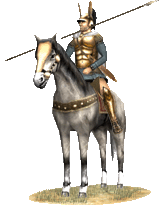 The Epeirotai did not have the ‘tradition’ of Alexandros to call upon, but they did have the ingenuity and forethought of Pyrrhos. Epeirotes guard cavalry are more lightly armored than their Makedonian counterparts, but they make up for this with an agility born of horsemanship in the mountains and valleys of Epieros. They are armed with the typical heavy cavalry equipment: a xyston, kopis, Boeotian helmet, and metal cuirass. However, they ride unarmored horses and are much faster than most heavy cavalry. The Epeirotai did not have the ‘tradition’ of Alexandros to call upon, but they did have the ingenuity and forethought of Pyrrhos. Epeirotes guard cavalry are more lightly armored than their Makedonian counterparts, but they make up for this with an agility born of horsemanship in the mountains and valleys of Epieros. They are armed with the typical heavy cavalry equipment: a xyston, kopis, Boeotian helmet, and metal cuirass. However, they ride unarmored horses and are much faster than most heavy cavalry.
Historically, Epeirotes cavalry dealt stinging blows to its enemies. Epeirotai smashed Illyrioi, Hellenes, Makedonians, and Romaioi with this decidedly Alexandrian guard cavalry. These men ought to be used in any situation that calls for speed, precision, and shock.
Elephantes Indikoi (Indian Elephants)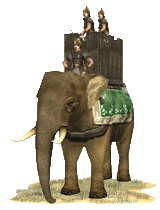 Imported from the regions around the old Eastern Persian provinces, Elephantes Indikoi are an exceptionally valuable resource in combat, very popular among Alexandros' Diadochoi. Towering over most other creatures, they can easily scare men and horses alike, with both their size and smell, though elaborate bells and trappings often add to their intimidation. Such corps are directed by their own mahouts riding behind their heads, often a native of their own country who has spent at least two years training his beast from capture. The mahout is armored to better protect against the obvious assault that generally comes against him, launched to bypass the thick natural armor of his mount. Imported from the regions around the old Eastern Persian provinces, Elephantes Indikoi are an exceptionally valuable resource in combat, very popular among Alexandros' Diadochoi. Towering over most other creatures, they can easily scare men and horses alike, with both their size and smell, though elaborate bells and trappings often add to their intimidation. Such corps are directed by their own mahouts riding behind their heads, often a native of their own country who has spent at least two years training his beast from capture. The mahout is armored to better protect against the obvious assault that generally comes against him, launched to bypass the thick natural armor of his mount.
Elephants are best used as cavalry screens for your army, where their presence can scare away enemy cavalry. They can also be used to ram through an enemy battle line, though they are less useful when faced with loose order or phalanx infantry. Pyrrhos of Epeiros even innovated a tactic of flank screens when he fought the Romans at Heraklea. Beyond their obvious use against enemy infantry or cavalry, they can also be used in siege combat; battering down gates, though they're highly vulnerable to better prepared installations. Their greatest vulnerability is against skirmishers, slingers and archers, who can pepper them with missiles - eventually toppling them by virtue of their cumulative impact. To counter the effect of enemy skirmishers, it is often wise to array your own in opposition, or to maintain constant attacks upon each individual group.
Historically, the use of elephants in war was largely contained to India, but after the battle of Hydaspes that changed. Though Alexandros never cared over much for the animals, his successors were very much in favor of their use, organizing their own elephants into a distinct corps under their own "elephantarchos". These "Elephantes Indikoi" (Indian Elephants) were imported for war in the West from the old Eastern Persian provinces around Baktria, Gandhara, Sattagydia, and Sind - though most originally hailed from the regions directly around the river the natives call the Sindhu. In the first wars of succession, each Diadochoi had a contingent of Indian elephants and Indian mahouts, who stayed on where they taught the Hellenes how to capture and train elephants for war. Such forces had been wreaking havoc on battle lines for centuries within the armies of Indian Rajas, and the Diadochoi used them on an equal scale (the first substantial group supposedly numbered 500 elephants total, granted to Seleukos I Nikator by his new ally Chandragupta Maurya, called "Sandrokottos" in Greek), attaching substantial political power to their possession - some officers gained temporary power and success simply by this virtue (most notably, the Eastern Satrap Eumenes).
Despite their great usefulness when properly employed, it was not unusual for elephants to cause defeat for those who employed them. If an enemy was clever enough to devise their own means to combat elephants, as was the case at the battle of Gaza when Ptolemaios planted an ‘iron spiked minefield’ to ward off elephants, or when Caesar properly utilized slingers and Scipio gaps between his infantry cohorts to channel the elephants, they could be defeated and even turned against their masters. Even pigs were used on occasion, released among elephants who were often scared of their comparatively small, darting forms. However, despite the many different weapons and stratagems being devised to fight them and the huge expenses required to maintain them, the elephant was still considered a valuable asset, maintained widely. The Arche Seleukeia even developed a corps of ‘elephant guards,' whose task was simply to defend the beasts in combat.
Other non-Hellenic powers also used Indian elephants in war, but it seems not to the same great extent. These powers started using elephants when they gained control of Indian provinces, such as the Pahlava, Kushan Empire and the Indo-Saka kingdoms.
Illyrioi Paraktioi (Illyrian coastal levies)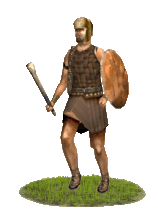 Those men when not using their boats to plunder enemy coasts or shipping, are on the lookout for easy pickings, be it from the enemies that surround them or other Illyrian tribes in their vincinity. Their helmet is a standard Illyrian helmet, simple and trustworthy. Armed with a crude mace, and a rope that they use when they assault enemy ships, to either grab them using hooks, or tie up their slaves after the fact. Rowdy and fierce against unarmed civillians, they tend to flee when armed enemies arrive. Brilliant in ambush and cunning in deceit, they can fill the ranks, but not quite hold them. Those men when not using their boats to plunder enemy coasts or shipping, are on the lookout for easy pickings, be it from the enemies that surround them or other Illyrian tribes in their vincinity. Their helmet is a standard Illyrian helmet, simple and trustworthy. Armed with a crude mace, and a rope that they use when they assault enemy ships, to either grab them using hooks, or tie up their slaves after the fact. Rowdy and fierce against unarmed civillians, they tend to flee when armed enemies arrive. Brilliant in ambush and cunning in deceit, they can fill the ranks, but not quite hold them.
Historically, Illyrians were notorious as pirates of the Adriatic. Their tribes, used small boats and ambush to offset any quality or quantity of troops stacked against them. They were very succesful. Agathokles of Sicily organised colonising expeditions in the Northern Adriatic, with stopping Illyrian piracy as a stated goal. Later it got worse. In fact Romani first expanded across the Adriatic, as an attempt to stamp off their acts of piracy.
Illyrioi Hippeis (Illyrian Light Cavalry)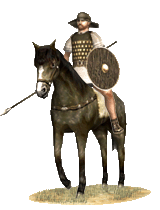 The Illyrioi field a light cavalry that has surprising tenacity on the battlefield. Armed with spears and axes, they are ideal for riding down routing infantry and attacking the flanks of vulnerable phalanxes. While not quite as useful as some cavalry, they have a definite presence as a somewhat inexpensive all-purpose melee cavalry. The Illyrioi field a light cavalry that has surprising tenacity on the battlefield. Armed with spears and axes, they are ideal for riding down routing infantry and attacking the flanks of vulnerable phalanxes. While not quite as useful as some cavalry, they have a definite presence as a somewhat inexpensive all-purpose melee cavalry.
Historically, the Illyrioi were a people that inhabited modern Albania, Bosnia, Croatia, Slovenia, Serbia and Montenegro. They were greatly influenced by their Hellenic neighbors to the south and their Makedonian neighbors to the east, but managed to stay fiercely independent until conquered by Philippos of Makedonia and Alexandros of Epeiros. That same fierceness allows them to be a reliable and fitting unit for any Epeirotes general that is clever enough to control the wild Illyrioi provinces.
Illyrioi Thureophoroi (Illyrian spearmen)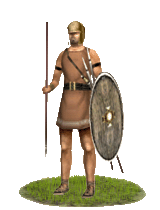 Sapping Ability\n\nLighter than the Hellenic Hoplites, that they used to fight, and equipped with a different shield, a deffinite Keltoi influence, the Illyrioi Thureophoroi, can hold the line, if needed, but their role was to harass rather than fight, and shower the enemy with spears from afar, not go up against it. At this they excell, as it is the very lack of armor which makes them very agile. Only their bronze Illyrian helmet can be considered armor as well as their thrureos shield. They carry a healty amount of javelins which they throw at the enemy but when it comes to close action with their spears, they leave a lot to be desired. Sapping Ability\n\nLighter than the Hellenic Hoplites, that they used to fight, and equipped with a different shield, a deffinite Keltoi influence, the Illyrioi Thureophoroi, can hold the line, if needed, but their role was to harass rather than fight, and shower the enemy with spears from afar, not go up against it. At this they excell, as it is the very lack of armor which makes them very agile. Only their bronze Illyrian helmet can be considered armor as well as their thrureos shield. They carry a healty amount of javelins which they throw at the enemy but when it comes to close action with their spears, they leave a lot to be desired.
Historically, Illyrioi were hammered by the same force that destroyed Makedonia and killed its king, Keraunos: the Keltoi. As one of the nations to border with them, the Boii nation of them, they did use a lot of their methods in fighting and mixing with their own peltasts, a heavier version was created, the Thureophoroi. While lighter than Hellenic Thureophoroi, they are as good as them or even better when it comes to harassing the enemy and especially pike phallanxes.
Hippeis Tarantinoi (Tarantine Elite Cavalry) Hippeis Tarantinoi are a superb elite cavalry that long ago made their home city of Taras, on the southern coast of Italia, famous for its own modest equestrian tradition. They wear light, high quality linen armor and charge into combat with a curved kopis blade and several javelins to weaken enemies for their charge or sustained melee fighting. In appearance and style they are a distinct, traditional Hellenic light cavalry, but fight with far more skill then their less recognizable predecessors from Hellas itself. As a force, they can be relied upon in any situation to perform as missile cavalry or as melee troops, providing that they do not get bogged down in the thick of battle. Hippeis Tarantinoi are a superb elite cavalry that long ago made their home city of Taras, on the southern coast of Italia, famous for its own modest equestrian tradition. They wear light, high quality linen armor and charge into combat with a curved kopis blade and several javelins to weaken enemies for their charge or sustained melee fighting. In appearance and style they are a distinct, traditional Hellenic light cavalry, but fight with far more skill then their less recognizable predecessors from Hellas itself. As a force, they can be relied upon in any situation to perform as missile cavalry or as melee troops, providing that they do not get bogged down in the thick of battle.
Historically, the Hippeis Tarantinoi were the elite cavalry force of Taras, an old foundation of Sparta on the southern coast of Italia. They were fairly unique among the various cavalries produced in the Hellenic tradition, as outside of the successors of Megas Alexandros, most such states were never recognized for the maintainance of an effective cavalry force - outside of Thessalonika. With them to form an effective compliment to their less impressive citizen infantry, Taras and the cities and Hellenes under its authority were able to hold the Lukanoi and Bruttiai at bay for many years, and were eventually used to some effect in the Epeirote army fashioned by Pyyrhos.
Aichmetai Leukanoi (Lucanian Light Infantry)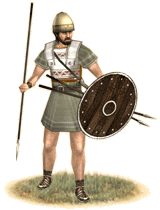 Lucanian Light Infantry are deployed and used as most javelin-equipped skirmishers. They run forward to pepper an enemy with javelins, and then withdraw before a counter-attack can be organised. Their job is to screen the main force of the army, and harass the enemy with a shower of javelins to disrupt their formation, so the more heavier infantry can engage with better odds. The Lucanian light infantry are equipped with javelins, a knife and nothing more. Their speed is their best and only armour. Any wise general should thus try to keep them unexposed to enemy cavalry, as in melee the light infantry will quickly rout. Lucanian Light Infantry are deployed and used as most javelin-equipped skirmishers. They run forward to pepper an enemy with javelins, and then withdraw before a counter-attack can be organised. Their job is to screen the main force of the army, and harass the enemy with a shower of javelins to disrupt their formation, so the more heavier infantry can engage with better odds. The Lucanian light infantry are equipped with javelins, a knife and nothing more. Their speed is their best and only armour. Any wise general should thus try to keep them unexposed to enemy cavalry, as in melee the light infantry will quickly rout.
Historically, the Lucanians occupied the province of Calabria in the 4th century B.C, except for the Greek coastal colonies. They were either at war or allied with their neighbours throughout their history. They allied themselves with Pyrrhus of Epeiros when he invaded, and although defeated and subjugated by Romans after the Pyrrhic War, they joined Hannibal during the Second Punic War and raised an army of 20.000 men to fight for him. After the war ended, the Lucanians were defeated again, and their homeland and population was devastated. The Social War in 91-88 B.C saw the end of them as a people.
|
 |
|
 |






















|